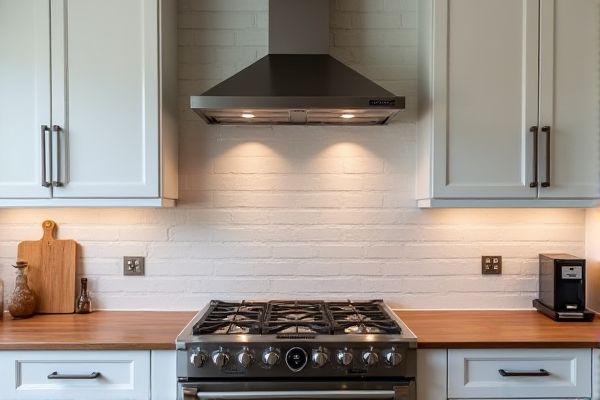
Range hood inserts offer a seamless, built-in look by fitting directly into cabinetry, while chimney hoods are standalone units with an exposed chimney for venting smoke and odors. Explore this article to determine which hood style best suits Your kitchen design and ventilation needs.
Table of Comparison
| Feature | Range Hood Insert | Chimney Hood |
|---|---|---|
| Design | Built-in, concealed inside cabinetry | Exposed, mounted on wall with visible chimney |
| Installation | Requires custom cabinet cutout | Easier, mounts directly to wall |
| Airflow | Powerful, options for vented or recirculating | Strong airflow with direct venting |
| Space Saving | Compact and integrated | Requires wall space, larger footprint |
| Noise Level | Varies; can be quieter when enclosed | Moderate noise, depends on motor |
| Maintenance | Filters accessible through cabinetry | Easy access for cleaning filters |
| Aesthetics | Minimalistic, hidden design | Stylish focal point, modern look |
| Price | Generally lower cost | Usually higher cost due to design |
Introduction to Range Hood Insert vs Chimney Hood
Range hood inserts are designed to fit seamlessly inside custom cabinetry, offering a sleek and integrated ventilation solution for your kitchen. Chimney hoods feature a prominent, often stainless steel, exterior that extends visibly from the cooking area, providing powerful exhaust performance with a stylish focal point. Choosing between a range hood insert and a chimney hood depends on your kitchen design preferences and ventilation needs.
What Is a Range Hood Insert?
A range hood insert is a hidden ventilation unit designed to fit inside custom cabinetry or a built-in enclosure, providing powerful smoke and odor extraction without disrupting kitchen aesthetics. Unlike a chimney hood, which is a standalone, visible fixture with a classic vertical vent design, range hood inserts offer a seamless, integrated look tailored to your kitchen layout. Your choice between these depends on whether you prioritize discreet installation or statement-making design.
What Is a Chimney Hood?
A chimney hood is a kitchen ventilation system designed to remove smoke, odors, and grease by drawing air upward through a vent that resembles a chimney, often mounted on the wall or ceiling above your cooktop. Unlike range hood inserts that fit inside cabinetry, chimney hoods have a visible, stylish exterior housing that enhances kitchen aesthetics while providing powerful extraction. Your choice between these depends on whether you prioritize seamless integration or a prominent, decorative appliance.
Design and Aesthetic Differences
Range hood inserts offer a sleek, built-in design that allows for seamless integration into cabinetry, maintaining a minimalist and unobtrusive kitchen look. Chimney hoods feature a prominent vertical structure that extends from the cooktop to the ceiling, often serving as a visual focal point with their stainless steel or glass finishes. The design choice impacts kitchen aesthetics, with inserts providing subtlety and chimneys delivering bold, architectural statements.
Installation Process and Requirements
Range hood inserts require precise cabinet modification and are designed to fit seamlessly within existing cabinetry, demanding professional installation for optimal duct alignment and electrical connection. Chimney hoods, featuring a visible vent pipe extending to the ceiling, generally necessitate wall mounting and more structural support to accommodate the protruding chimney design. Both types require proper ventilation planning, but chimney hoods often involve more extensive wall or ceiling penetrations to ensure effective smoke and odor extraction.
Ventilation Performance Comparison
Range hood inserts provide customizable ventilation options with high extraction power, ideal for kitchen remodels requiring seamless integration into cabinetry. Chimney hoods typically offer strong airflow and wider coverage, excelling at capturing smoke and odors, especially in larger kitchens. Ventilation performance varies by model, but chimney hoods generally deliver more effective smoke expulsion, while inserts allow for tailored venting solutions.
Space and Layout Considerations
Range hood inserts offer a sleek, customizable option that integrates seamlessly into your existing cabinetry, maximizing kitchen space and maintaining a clean layout. Chimney hoods require dedicated wall space and are more prominent, potentially influencing the kitchen's overall design and spatial arrangement. Your choice depends on the available space and how you envision the kitchen flow and aesthetic.
Maintenance and Cleaning Needs
Range hood inserts require regular cleaning of filters and internal components to maintain optimal airflow and efficiency. Chimney hoods often include larger, more accessible filter areas which can simplify maintenance but may accumulate grease more quickly due to open designs. Your choice should balance ease of cleaning with the frequency of use and kitchen ventilation demands.
Cost Analysis: Initial and Ongoing Expenses
Range hood inserts generally have a lower initial cost compared to chimney hoods, making them a budget-friendly option for kitchen ventilation. Ongoing expenses for inserts can be reduced since they integrate seamlessly into existing cabinetry, minimizing installation costs. Chimney hoods, while more expensive upfront due to their design and materials, may incur higher maintenance costs over time because of exposed surfaces and specialized filters.
Which Hood Is Best for Your Kitchen?
Range hood inserts offer a sleek, customizable option ideal for seamless integration into cabinetry, maximizing your kitchen's aesthetic and space efficiency. Chimney hoods provide powerful ventilation with a prominent design that effectively removes smoke and odors, making them suitable for larger or open-concept kitchens. Your choice depends on the kitchen layout, ventilation needs, and whether you prioritize discreet installation or visible, high-performance extraction.
 homyna.com
homyna.com